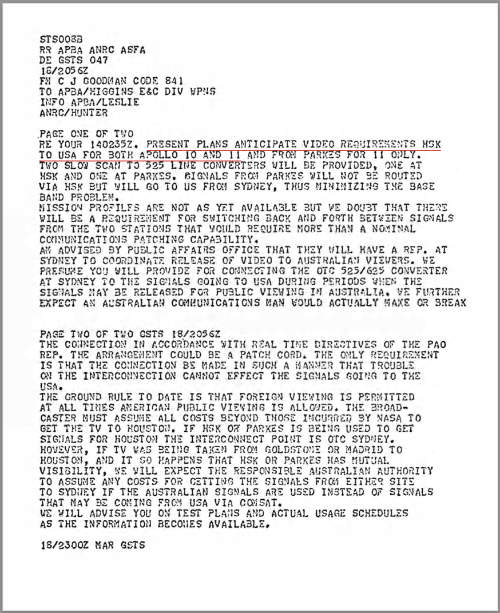Plans for a direct feed to Australian TV networks
In early 1969, NASA made plans to release the TV from Sydney Video direct to the Australian domestic TV networks.
Since it was expected that the lunar TV would be received in Australia and then relayed by satellite to the USA, the decision was made (in line with existing NASA policy) to allow the Apollo 11 EVA TV to be released to the Australian networks direct from Sydney Video.
Although the Australian networks also had a satellite feed coming from Houston, this local access allowed Australian viewers to see the pictures moments before American viewers. Additionally, the picture seen in Australia did not suffer from satellite and long distance terrestrial transmission to and from Houston.
A consequence of this arrangement is that the audio heard by Australian viewers was slight delayed with respect to the picture they were seeing, since the audio was released from Houston, with occasional commentary from NASA’s Public Affairs Officer Jack Riley in Mission Control.
Goddard Space Flight Center’s Charlie Goodman was the cognizant engineer planning the overall TV paths to and from Sydney Video. This 18 March 1969 TWX (network teletype message) from Goodman to his contact at WRE’s Electronics and Communications Division shows the current state of planning for the broadcast. It was later decided to base the Parkes scan converter at Sydney Video due to bandwidth constraints on the Parkes – Sydney microwave link.
The TWX was copied to Bob Leslie at the Department of Supply’s American Projects Branch, and to Willson Hunter, the NASA Senior Scientific Representative to Australia.
Bold text has been added, and the source memo is below.
“Present plans anticipate video requirements HSK to USA for both Apollo 10 and 11 and from Parkes for 11 only. Two slow scan to 525 line converters will be provided, one at HSK and one at Parkes. Signals from Parkes will not be routed via HSK but will go to us from Sydney, thus minimizing the base band problem.
Mission profiles are not as yet available but we doubt that there will be a requirement for switching back and forth between signals from the two stations that would require more than a nominal communications patching capability.
Am advised by Public Affairs Office that they will have a Rep. at Sydney to coordinate release of video to Australian viewers. We presume you will provide for connecting the OTC 525/625 converter at Sydney to the signals going to USA during periods when the signals may be released for public viewing in Australia. We further expect an Australian communications man would actually make or break the connection in accordance with real time directives of the PAO rep. The arrangement could be a patch cord. The only requirement is that the connection be made in such a manner that trouble on the interconnection cannot effect the signals going to the USA.
The ground rule to date is that foreign viewing is permitted at all times American public viewing is allowed. The broadcaster must assume all costs beyond those incurred by NASA to get the TV to Houston. If HSK or Parkes is being used to get signals for Houston the interconnect point is OTC Sydney. However, if TV was being taken from Goldstone or Madrid to Houston, and it so happens that HSK or Parkes has mutual visibility, we will expect the responsible Australian authority to assume any costs for getting the signals from either site to Sydney if the Australian signals are used instead of signals that may be coming from USA via Comsat.
We will advise you on test plans and actual usage schedules as the information becomes available.”
Goddard’s Charlie Goodman penned this TWX on 18 March 1969. From the Apollo 11 Telemetry tape Search team. |
Back to the main Apollo 11 TV page.
